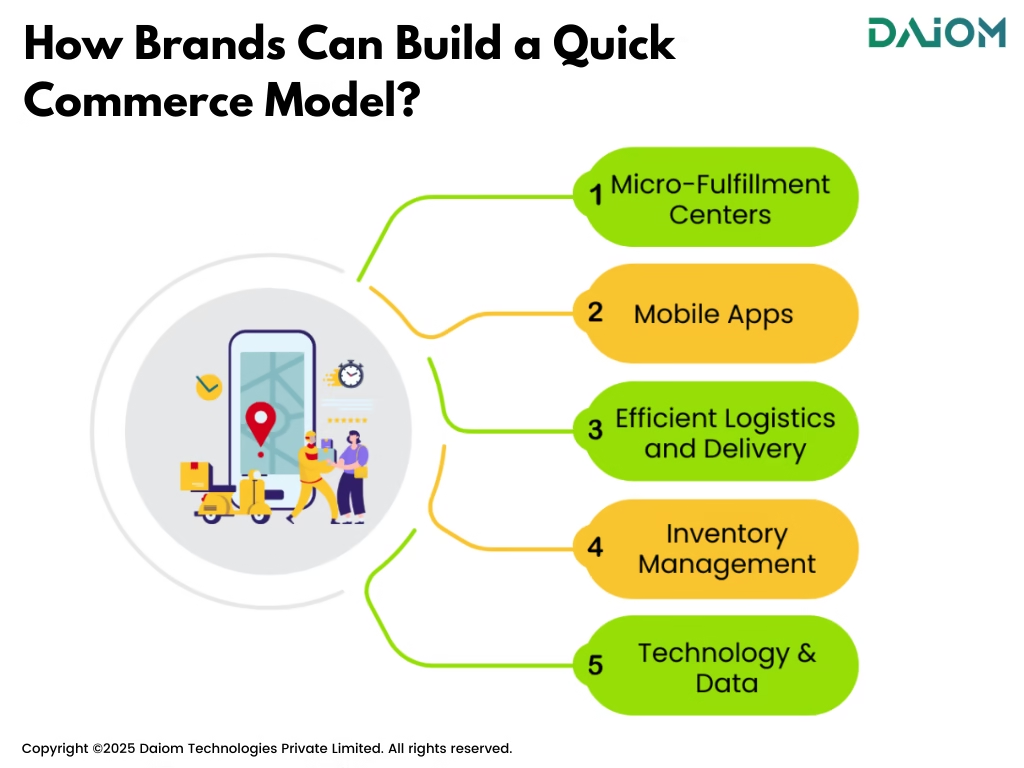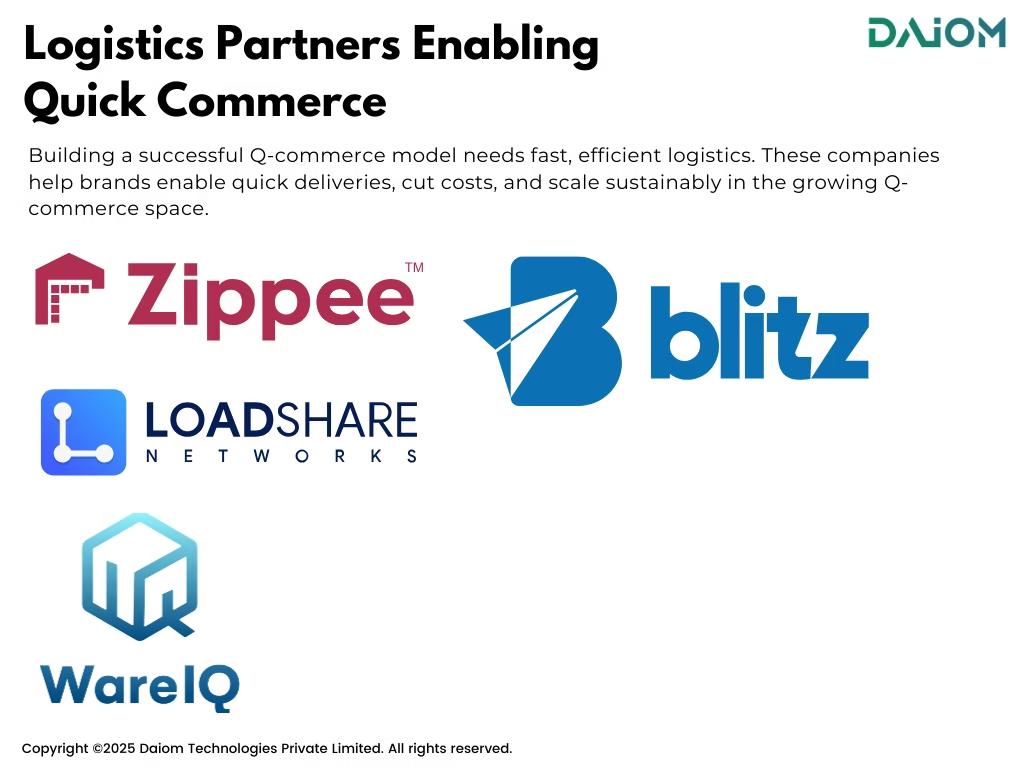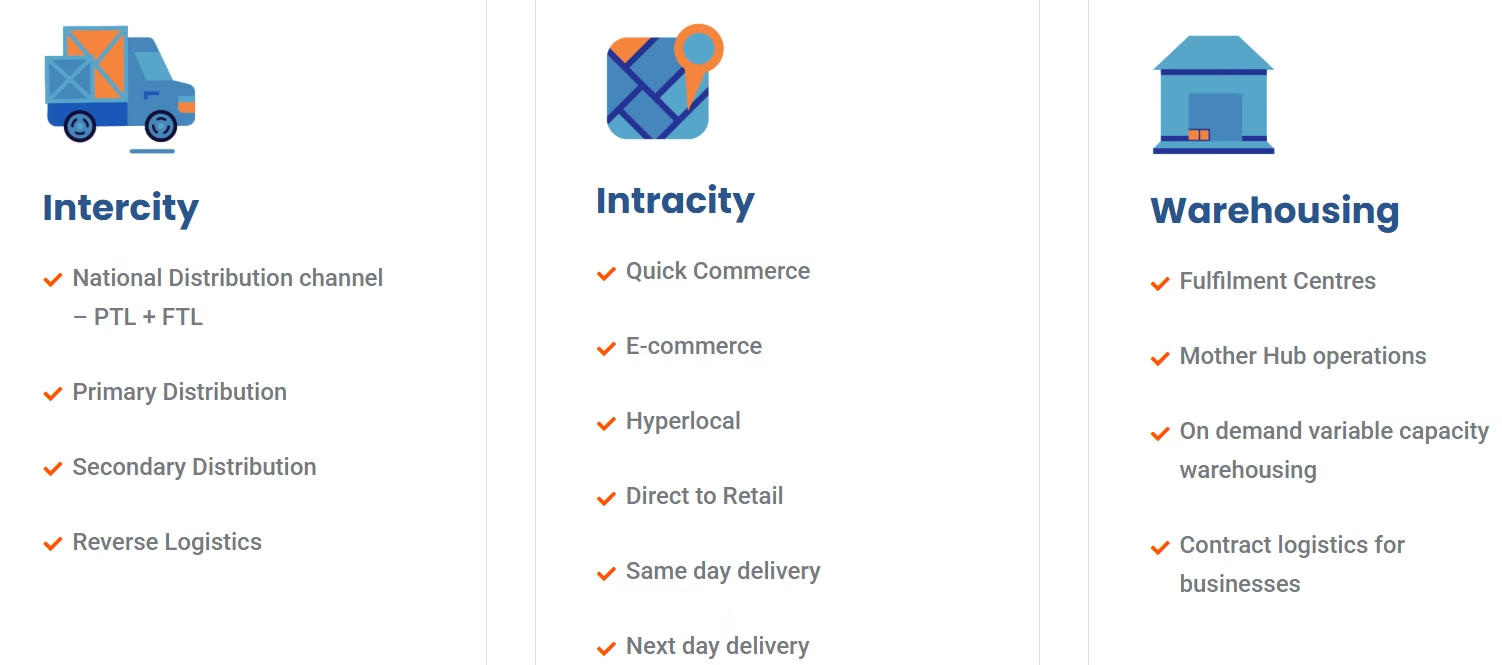Quick commerce (Q-commerce) is changing how people shop. Customers today don’t want to wait 2-3 days for their orders — they expect deliveries within a few hours.
This is why many omnichannel brands partner with platforms like Zepto, Swiggy Instamart, and Blinkit to offer faster deliveries. But, these platforms charge high commissions and brands have little control over the customer experience.
That’s why more omnichannel and d2c brands are now thinking — “Can we build our own quick commerce model?”
And the most important thing to make that happen is having a strong network of dark stores.
Dark stores are like small local warehouses where d2c, omnichannel and other brands store their products close to customers. The more dark stores you have, the more pin codes you can cover — and the faster you can deliver.
This is how leading players are scaling. As of March 2025:
- Zepto operates around 850 dark stores
- Swiggy Instamart has around 705 dark stores
Quick commerce is a growing $5.5 billion market in India, and the playbook is clear — if brands want to compete, they need to build distributed inventory, plan smartly for each location, and use data to power faster deliveries.
This blog breaks down how omnichannel and brands are doing it — and what it really takes to win in quick commerce.
Also Read – How D2C Brands Are Adapting to the Quick Commerce Boom?
Consumers expect instant gratification, and that is pushing faster and faster delivery times.
Table of Contents
1. What Does “Quick” Really Mean in Quick Commerce?
Traditional e-commerce deliveries would take 3-4 days. Then players like Amazon raised the bar with next-day or 2-day delivery — setting new customer expectations.
Quick commerce takes this even further. It’s not just about delivering in 10 minutes (that’s only for select use cases). The real goal is to make same-day or within-a-few-hours delivery the new normal across categories.
But speed alone isn’t enough — omnichannel and other brands need to balance speed with operational efficiency.
And that’s where distributed inventory comes in.
To enable faster delivery, d2c and omnichannel rands must set up a network of dark stores — small, hyperlocal warehouses that stock products based on local demand patterns.
It’s not about stocking everything everywhere. It’s about knowing what sells in which pin code — and planning inventory smartly to deliver faster, with lower wastage and better efficiency.
2. Why Are Dark Stores The Backbone of Quick Commerce?
For any brand planning to build its own quick commerce (Q-commerce) model, the biggest success factor is having a strong network of dark stores.
Dark stores are small, local warehouses that store inventory close to the customer. They enable faster deliveries because products are stocked within a few kilometers of where the order comes from.
Simply put — the more dark stores a brand has, the more pin codes it can cover. This becomes a key KPI for any brand entering quick commerce.
How Are Leading Players Scaling Their Dark Store Network?
Top players like Swiggy Instamart, Blinkit, Zepto, and Zomato are scaling their quick commerce operations primarily by expanding their dark store network.
Their growth strategy is simple — more dark stores = faster delivery = better customer experience.
As of the latest reports (March 2025):
- Swiggy Instamart operates around 705 dark stores across India.
- Zepto has scaled up even faster, with approximately 850 dark stores — and both companies are continuing to expand aggressively.
- Blinkit is also competing closely with a large dark store footprint across major cities.
For any new brand entering quick commerce, this becomes a clear benchmark — scaling dark stores is non-negotiable if you want to compete and win in this space.
3. Challenges in Quick Commerce
Building a quick commerce model also comes with its own set of challenges:
- SKU Complexity: Too many product options (SKUs) make distribution difficult. Quick commerce works best with a limited, high-demand assortment.
- Perishable Inventory: If you sell fresh or perishable products, wastage risk increases if demand isn’t accurate.
- Higher Inventory Cost: Stocking products in multiple dark stores increases working capital requirements. More inventory gets locked up across locations.
3.1 The Solution Lies in Data
To make quick commerce work, brands need to rely on data at every step. Data helps brands:
→ Forecast demand more accurately
→ Plan inventory better
→ Decide which products (SKUs) to stock in which dark stores
The smarter your data, the faster and leaner your supply chain.
And it’s best to start small — focus on a few top-performing pin codes, test quick commerce operations, learn from customer demand patterns, and then expand.
Because winning in quick commerce is not just about delivering fast — it’s about building a system that runs fast without wasting resources.
4. How Brands Can Build a Quick Commerce Model?
Brands that want to thrive in Q-commerce need to focus on efficiency and independence. Here’s how:

- Set Up Local Warehouses: Keeping inventory close to customers is key. Micro-fulfillment centers or local warehouses reduce delivery times and shipping costs, making Q-commerce more feasible.
- Leverage Tech & Automation: Invest in smart inventory management systems, AI-driven demand forecasting, and real-time tracking. Automation improves order accuracy and speeds up fulfillment.
- Partner with Logistics Experts: Rather than relying on costly third-party marketplaces, brands can work with specialized 3PL (third-party logistics) providers and last-mile delivery services to handle ultra-fast deliveries.
- Market Fast Delivery as a USP: Brands can build direct-to-consumer (D2C) Q-commerce by promoting same-day or next-hour delivery through their own websites, bypassing marketplace fees.
5. Case Studies: Brands Doing It Right!
Several brands have successfully implemented their own Q-commerce strategies:

- SNITCH: This fashion brand has built a strong direct-to-consumer (D2C) model, leveraging smart logistics and local distribution centers for rapid deliveries.
- Newme: By integrating tech-driven inventory tracking and local fulfillment centers, Newme has managed to scale Q-commerce profitably.
- DaMENSCH: This apparel brand has optimized warehousing and logistics, reducing reliance on high-fee platforms.
- Nykaa & Myntra: These companies have embraced Q-commerce through a mix of in-house fulfillment centers and strategic delivery partnerships.
- Lenskart: The eyewear giant has partnered with Zepto and uses hyperlocal warehouses to fulfill orders quickly while maintaining profitability.
These brands prove that an independent Q-commerce strategy is possible and profitable with the right approach.
6. Top Logistics Partners Enabling Quick Commerce
Building a successful Q-commerce model requires strong logistics support, as fast deliveries and efficient order fulfillment are crucial for meeting customer expectations.
Several logistics companies in India are helping brands streamline operations and execute ultra-fast deliveries while maintaining profitability.
By partnering with these logistics providers, brands can reduce their dependency on high-fee marketplaces, optimize delivery costs, and build a sustainable Q-commerce model.
These companies help brands enhance operational efficiency, improve customer experience, and scale profitably in the growing quick commerce space.
Here’s how each of them contributes to the Q-commerce ecosystem:

6.1 Zippie (Founded 2021, Delhi)
Specializes in hyperlocal delivery, enabling brands to fulfill orders within two hours. With a presence in 12+ cities, it serves 150+ brands through a network of 50+ dark stores, ensuring quick turnaround times for groceries, personal care, and fashion brands.
By leveraging a dense network of micro-warehouses and strategic delivery hubs, Zippie helps brands meet instant delivery expectations without high platform fees.
6.2 Blitz (Founded 2020, Gurgaon)
Blitz is a technology-driven logistics network that enables same-day delivery for e-commerce sellers across India. By integrating fulfillment centers and shipping partners, Blitz ensures ultra-fast deliveries, helping brands meet customer expectations for speed and convenience.

Trusted by over 100 brands and marketplaces, Blitz offers both post-checkout and pre-checkout solutions to enhance the shopping experience and drive conversions.
- Post-Checkout Solution: Orders are processed and delivered at Blitz speeds, with real-time order tracking available to customers, ensuring transparency and reliability.
- Pre-Checkout Solution: By displaying accurate and fast delivery timelines on websites, Blitz helps brands boost impulse purchases, giving customers confidence in quick deliveries.
- Optimized Inventory Placement: Blitz uses demand forecasting and strategic inventory distribution to reduce fulfillment costs. Brands can place the right stock in the right locations, ensuring efficiency and minimizing delays.
- Hyperfast Deliveries: Blitz specializes in 10-minute deliveries, making it one of the fastest logistics solutions for Q-commerce.
With its AI-driven routing and high-speed logistics network, Blitz empowers brands to scale their quick commerce operations, reduce dependency on marketplaces, and enhance profitability through seamless, ultra-fast order fulfillment.
6.3 Loadshare (Founded 2017, Bengaluru)
Loadshare is transforming logistics with a tech-driven, entrepreneur-led model, providing businesses with cost-effective and scalable solutions. The company has built a vast logistics network covering 10,000+ pin codes across metros, Tier 1 cities, and deep regions in East and Northeast India.

- Massive Scale & Reach: Loadshare handles 350+ tons of PTL freight daily, with a network of 100,000+ trucks and 10,000+ delivery partners, ensuring reliable deliveries across India.
- Optimized Cost Efficiency: By leveraging technology and an extensive logistics network, Loadshare helps businesses reduce operational costs while maintaining high efficiency.
- Custom Logistics Solutions: Whether for traditional enterprises or digital-native brands, Loadshare offers modular and customizable logistics solutions tailored to different business needs.
- Tech-First Innovation: Loadshare provides advanced WMS, TMS, and last-mile delivery tech, which can also be leased to SME logistics providers to enhance their capabilities.
- ONDC Pioneer: As the first logistics network partner for ONDC, Loadshare is leading on-network deliveries, currently piloting logistics solutions in 15 cities, including Bangalore, Mumbai, Delhi, Kolkata, and Pune. The company supports hyperlocal, same-day (SDD), and next-day deliveries (NDD) for F&B and groceries within ONDC’s framework.
6.4 WareIQ (Founded 2019, Bengaluru)
WareIQ provides Amazon Prime-like logistics solutions for modern eCommerce brands, enabling faster and more cost-effective deliveries across D2C, marketplaces, B2B, and quick commerce channels.
With a strong pan-India fulfillment network and a powerful SaaS platform, WareIQ helps brands streamline logistics operations while reducing costs.
Trusted by over 400 top online brands, WareIQ offers a pan-India network of 20+ fulfillment centers and dark stores, ensuring same-day and next-day deliveries. With a 99 percent on-time shipping rate and a 30 percent reduction in logistics costs, WareIQ optimizes both speed and efficiency.
WareIQ’s smart tech platform seamlessly integrates with 20+ D2C platforms and marketplaces, providing real-time order management and fulfillment tracking. The company’s expert team handles end-to-end operations, from inventory storage to last-mile delivery.
Its AI-powered courier allocation engine selects the best national, regional, or hyperlocal shipping partners for each order, balancing cost and speed.
With its scalable and technology-driven fulfillment model, WareIQ empowers brands to enhance customer experience and compete with the fastest eCommerce delivery standards in India.
7. Conclusion
Quick commerce is no longer just a trend—it’s the future of retail. While platforms like Zepto and Blinkit provide access to a vast customer base, their high fees can eat into profits, making long-term sustainability a challenge.
The key to success lies in owning the supply chain through local warehouses and direct logistics partnerships, investing in technology like AI-driven inventory management and real-time tracking, and optimizing fulfillment costs by working with third-party logistics providers instead of relying solely on marketplaces.
Brands that adopt these strategies will not only survive but thrive in the Q-commerce era. The future belongs to those who take control, cut costs, and deliver faster—without sacrificing profitability.
If you’d like to discuss how we can help enhance your quick commerce strategies, we’d be happy to set up a consultation call. Feel free to reach out to us at alibha@daiom.in
For more informative content and blog, follow and stay tuned to DAiOM.
Subscribe to our NEWSLETTER!


